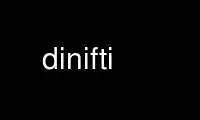
This is the command dinifti that can be run in the OnWorks free hosting provider using one of our multiple free online workstations such as Ubuntu Online, Fedora Online, Windows online emulator or MAC OS online emulator
PROGRAM:
NAME
dinifti - converts DICOM files into the NIfTI format
SYNOPSIS
dinifti [options] <DICOM input> <NIfTI output>
DESCRIPTION
dinifti converts a single or several files at once into the NIfTI data format. The DICOM
input can be specified as a single filename, a list of file or a directory. In case of a
directory all files in this directory will be converted.
Images belonging to the same recording series will be appropriately merged into a single
3d or 4d NIfTI file. To achieve this dinifti gathers the number of time points and number
of slices per volume from the DICOM header. When this is impossible, dinifti will issue a
warning (i.e. when it can find only 1 slice per volume and 1 time point). The user has the
option of running the program using the -s option and specifying the number of slices per
volume.
A number of items are retrieved from the Siemens Shadow set. Following is a list of items
and default value if this is not Siemens.
Number of groups: 1
Number of channels: 1
Sagital, Coronal and Transverse position: From DICOM (0020,0032)
OPTIONS
-g NIfTI files will be compressed.
-f [a2|n2|n1]
Set the output file format. If set to a2 ANALYZE 7.5 file pairs (hdr/img) will be
generates. Setting n2 will cause dinifti to generate NIfTI image file pairs. The
default output format (n1) are single NIfTI files (header and image data combined
in one file).
-d If set dinifti appends the series description from the DICOM header to the output
file name(s).
If two image series share a common description dinifti will append as many
characters as necessary to the second series description to create a unique
filename. In this case a warning message is displayed that shows the old and the
modified filename.
--name="<format>"
Format output file name(s) according to <format> string, which has to be enclosed
in quotes (")
The format is interpreted in the usual printf-like way. Ordinary characters are
directly copied, a percent sign is represented by %%, otherwise % indicates a
conversion. The special character "/" is translated to "~" to avoid confusion with
the directory separator.
If --name is present, -d flag will be ignored.
%I Subject ID
%N Subject name
%S Relative series number
%D Series description
%Y Series date (YYYYMMDD)
%T Series time (HHMM)
%A Accession number
%C Image comments
Example: --name="%Y:%T- %A - %I -%D(%S)"
-s # This option can be used to specify the number of slices in the volume, if dinifti
fails to autodetect the correct value.
-v, --verbose
Enables verbose status messages. If any warning message occurs, this option can be
helpful to determine which imageseries caused it.
-n, --noact
If set, dinifti performs all processing steps, but does not write NIfTI files at
the end. This can be useful to quickly inspect the content of a DICOM directory (if
ran together with --verbose).
-h, --help
Print this help page and exit.
-V, --version
Print the version number and exit.
Use dinifti online using onworks.net services
